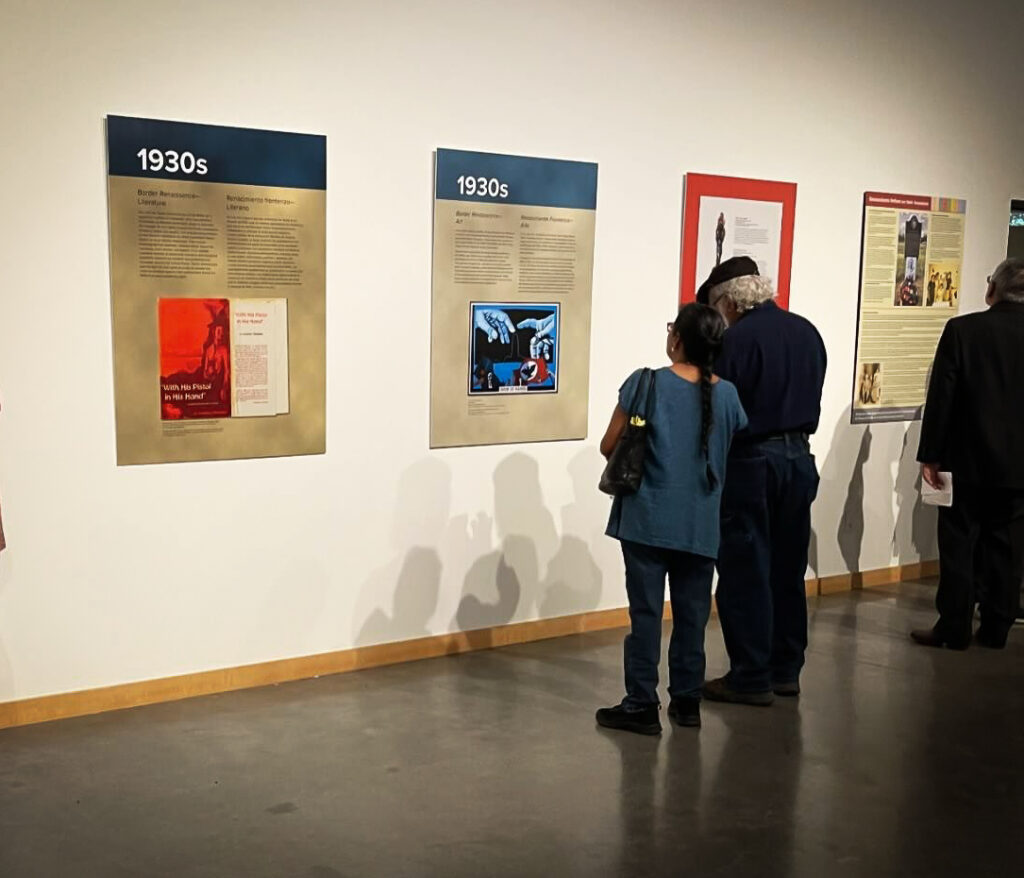By Ruben A. Arellano, 2024
The Mexican American Museum of Texas just celebrated its second year of existence, and in that time, it has brought three exhibits to North Texas. The museum’s tireless board members have worked hard to spread its message of preserving the deep roots of ethnic Mexicans in Texas and creating exhibits that showcase that history. The first exhibit centered on the tradition of making tamales around the winter holidays, and the second one focused on the experiences of Texas Mexican women, Tejanas, who were present at the famed battle of the Alamo. Inspired by the bicentennial celebrations surrounding the supposed founding of the Texas Rangers in 1823, for its third exhibit, the museum partnered with Refusing To Forget to bring The “Life and Death on the Border 1910 to 1920” exhibit to North Texas. The exhibit seeks to present the histories of the people who lived on the border and their stories of violence committed against the Mexicans by the Texas Rangers.
It took time to find a venue that would partner with the museum. Most places had a two-year waiting list, but a few of those rejections surfaced because of an apprehension about the sensitivity of the subject and the optics of being associated with an exhibit that critiques law enforcement. One venue was initially genuinely interested but our request was ultimately declined because a few of their board members were uncomfortable with the potential anti-law enforcement criticism it would receive. The TMAMT museum board explained that the purpose of the exhibit is to present a different perspective on the role of the Texas Rangers and other agents of power. But fear of being targeted in the current political climate proved to be stronger than the facts.
What are the facts presented in the exhibit? According to Texas lore, Stephen F. Austin is said to have hired a group of men to act as rangers to protect new (white?) settlers from Native Americans in 1823. While indigenous people resisted Anglo encroachment on their lands, it’s this creation story that the Texas Rangers choose to subscribe to. The more likely origin of the Texas Rangers began with a group called The Permanent Council, a temporary governing body in 1835, that formally created the Texas Rangers as a quasi-paramilitary force called the “Corps of Rangers.”
What is certain is that the governing entity created the paramilitary force to target Native Americans along the Texas frontier. The Texas Rangers Hall of Fame and Museum describes the Corps of Ranger’s mission as, “to protect the frontier from hostile Indians.” This is an interesting historical interpretation that leaves out any mention of the atrocities committed by Anglo settlers unto Native communities. Eventually, the Ranger duties also included targeting ethnic Mexicans on both sides of the US-Mexico border. Due to anti-Mexican attitudes, and the indigenous ancestry of ethnic Mexicans, often brought up as a negative characteristic of the people, Mexicans were just another group of “Indians” to be dealt with.
While the exhibit sheds light on the horrific violence that took place in the early 1900s, it also recounts the various ways in which mexicanos lived, loved, and persevered despite being targets of racially motivated attacks. At the time, the ethnic Mexican community of South Texas was primarily comprised of people with deep generational roots stemming from the early Spanish settlements and the various indigenous peoples who were assimilated into the Tejano community. There was also a steady back and forth migration at a time when the border was not the hyper militarized boundary it is today, and people moved about freely across national lines. Thus, the people of the border, the “fronterizos,” have always perceived themselves as a singular community straddling an imaginary divide.
It’s useful to note here that this year marks the one-hundredth anniversary of the creation of the US Customs and Border Patrol in 1924. Its development was in part a response to the violence that had occurred just a few years prior during the decade of 1910 and 1920. This is the focus period in the “Life and Death on the Border” exhibit, a time of great violence and upheaval along the Texas-Mexico border. Simply glossing over the uncomfortable truths to celebrate a bicentennial does a disservice to the memory of the lives lost. The descendants of the people killed by those who were sworn to uphold the law deserve better, and a public apology from the Texas Rangers and the State of Texas would help start to the healing process of these generational wounds. That is the reason for the exhibit, to shed light on the facts and bring awareness to the wider public on the tragic events that occurred along the borderlands over a century ago.
The “Life and Death on the Border” exhibit examines the causes and effects of state-sanctioned racial violence against ethnic Mexicans and explores the actions taken by Mexican Americans to advance justice and civil rights. It highlights the violent role that the Texas Rangers played in this story, but it also showcases the resilience of the Mexican American community through their cultural expression, mutual aid, and political activism. The exhibit concludes by examining the lasting impact of the violence and the ongoing struggles for justice and equality. Ultimately, our goal is to inspire thoughtful historical criticism by challenging the popular imaginary and humanizing the victims of violence and those who perpetrated it. Like all humans, the Texas Rangers were just as fallible as anyone, and the truth about their checkered past must be told. More importantly, it is the hope of The Mexican American Museum of Texas that the exhibit helps bring a sense of dignity to those affected by the violence, and that the public gains a fuller understanding of the Mexican American experience in Texas.
The exhibit is currently on view through October 15, 2024, at the Beatrice M. Haggerty Gallery – University of Dallas, Irving. We are grateful that the University of Dallas accepted our request and agreed to partner with the museum to bring this much needed exhibit to Dallas-Fort Worth area.

Ruben A. Arellano, Professor of History at Dallas College – Mountain View Campus and Mexican American Museum of Texas board member, is the author of “Radicals and Reformers in the ‘Big D’: The Rise of Ethnic Mexican Politics in Dallas, Texas; 1969–1980,” Journal of South Texas 35, no. 1 (Spring 2021): 24–55.
Title Photo Credit : https://www.facebook.com/TheMexicanAmericanMuseumofTexas

